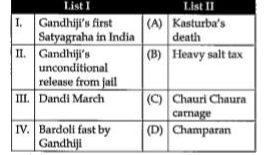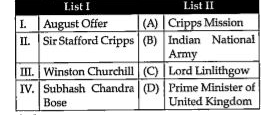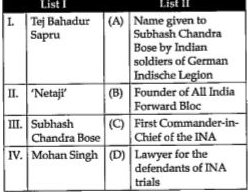Match List I with List II and select the correct answer using the codes given below the lists :
List IList IIa.BBr3i.Dimerb.Tl2Oii.Trigonol planarc.B(OH)3iii.Basicd.AlCl3iv.Monobasic acid
x2+y
2x+y2
2x−y2
y−2x2
The correct Answer is:2
To solve the matching question between List I and List II, we will analyze each compound in List I and determine its corresponding property from List II.
1. Identify the first compound: BBr₃
- Boron (B) has a valency of 3 and forms three bonds with bromine (Br), which is monovalent.
- The geometry of BBr₃ is trigonal planar due to the three bonding pairs and no lone pairs on the boron atom.
- Match: BBr₃ → ii. "Trigonol planar"
2. Identify the second compound: Tl₂O
- Thallium (Tl) in Tl₂O can exhibit a +1 oxidation state. The oxygen atom has lone pairs and can act as a Lewis base.
- The compound is basic in nature due to the presence of oxygen which can donate lone pairs.
- Match: Tl₂O → iii. "Basic"
3. Identify the third compound: B(OH)₃
- Boric acid (B(OH)₃) is known to be a monobasic acid. It can accept hydroxide ions (OH⁻) to form B(OH)₄⁻, indicating its monobasic nature.
- Match: B(OH)₃ → iv. "Monobasic acid"
4. Identify the fourth compound: AlCl₃
- Aluminum chloride (AlCl₃) dimerizes to form Al₂Cl₆. In the dimer, aluminum accepts electron pairs from chlorine, forming a three-center two-electron bond.
- Match: AlCl₃ → i. "Dimer"
Final Matches:
- a → ii (BBr₃ → "Trigonol planar")
- b → iii (Tl₂O → "Basic")
- c → iv (B(OH)₃ → "Monobasic acid")
- d → i (AlCl₃ → "Dimer")
Answer Codes:
The correct answer using the codes given below the lists is:
- a: ii
- b: iii
- c: iv
- d: i
- Boron (B) has a valency of 3 and forms three bonds with bromine (Br), which is monovalent.
- The geometry of BBr₃ is trigonal planar due to the three bonding pairs and no lone pairs on the boron atom.
- Match: BBr₃ → ii. "Trigonol planar"
- Thallium (Tl) in Tl₂O can exhibit a +1 oxidation state. The oxygen atom has lone pairs and can act as a Lewis base.
- The compound is basic in nature due to the presence of oxygen which can donate lone pairs.
- Match: Tl₂O → iii. "Basic"
- Boric acid (B(OH)₃) is known to be a monobasic acid. It can accept hydroxide ions (OH⁻) to form B(OH)₄⁻, indicating its monobasic nature.
- Match: B(OH)₃ → iv. "Monobasic acid"
- Aluminum chloride (AlCl₃) dimerizes to form Al₂Cl₆. In the dimer, aluminum accepts electron pairs from chlorine, forming a three-center two-electron bond.
- Match: AlCl₃ → i. "Dimer"
- a → ii (BBr₃ → "Trigonol planar")
- b → iii (Tl₂O → "Basic")
- c → iv (B(OH)₃ → "Monobasic acid")
- d → i (AlCl₃ → "Dimer")
The correct answer using the codes given below the lists is:
- a: ii
- b: iii
- c: iv
- d: i
Topper's Solved these Questions
- P BLOCK ELEMENTSBook:RESONANCE ENGLISHChapter:P BLOCK ELEMENTSExercise:INORGANIC CHEMISTRY(P-Block Elements)
Explore 35 Videos
- P BLOCK ELEMENTSBook:RESONANCE ENGLISHChapter:P BLOCK ELEMENTSExercise:Example
Explore 30 Videos
- NUCLEAR CHEMISTRYBook:RESONANCE ENGLISHChapter:NUCLEAR CHEMISTRYExercise:STAGE-II
Explore 1 Video
- P-BLOCK ELEMENT (BORON AND CARBON FAMILY)Book:RESONANCE ENGLISHChapter:P-BLOCK ELEMENT (BORON AND CARBON FAMILY)Exercise:PART - III : OLYMPIAD PROBLEMS (PREVIOUS YEARS) STAGE - V (INTERNATIONAL CHEMISTRY OLYMPIAD (IChO)) Problem 3
Explore 8 Videos
Similar Questions
Knowledge Check
Match List I with List II and select the correct answer by using the codes given below the lists:
 AI-D, II - A, III -B, IV-CBI-A, II – D, III -C, IV-BCI-A, II – D, III – B, IV-CDI-D, II -C, III – B, IV-A
AI-D, II - A, III -B, IV-CBI-A, II – D, III -C, IV-BCI-A, II – D, III – B, IV-CDI-D, II -C, III – B, IV-AMatch List I with List II and select the correct answer by using the codes given below the lists:

 AI-D, II - A, III - C, IV-BBI-B, II - D, III-A, IV-CCI-A, II – D, III – B, IV-CDI-D, II-A, III -B, IV-C
AI-D, II - A, III - C, IV-BBI-B, II - D, III-A, IV-CCI-A, II – D, III – B, IV-CDI-D, II-A, III -B, IV-CMatch List I with List II and select the correct answer by using the codes given below the lists:
 AI-D, II – A, III - C,IV-BBI-A, II-D, III -C, IV-BCI-A, II -D, III - B, IV-CDI-D, II-A, III -B, IV-C
AI-D, II – A, III - C,IV-BBI-A, II-D, III -C, IV-BCI-A, II -D, III - B, IV-CDI-D, II-A, III -B, IV-C
Match List I with List II and select the correct answer by using the codes given below the lists:

View SolutionMatch List I with List II and select the correct answer by using the codes given below the lists:

View SolutionMatch List I with List II and select the correct answer by using the codes given below the lists:

View SolutionMatch List I with List II and select the correct answer by using the codes given below the lists :

View SolutionMatch List I with List II and select the correct answer by using the codes given below the lists :

View Solution


